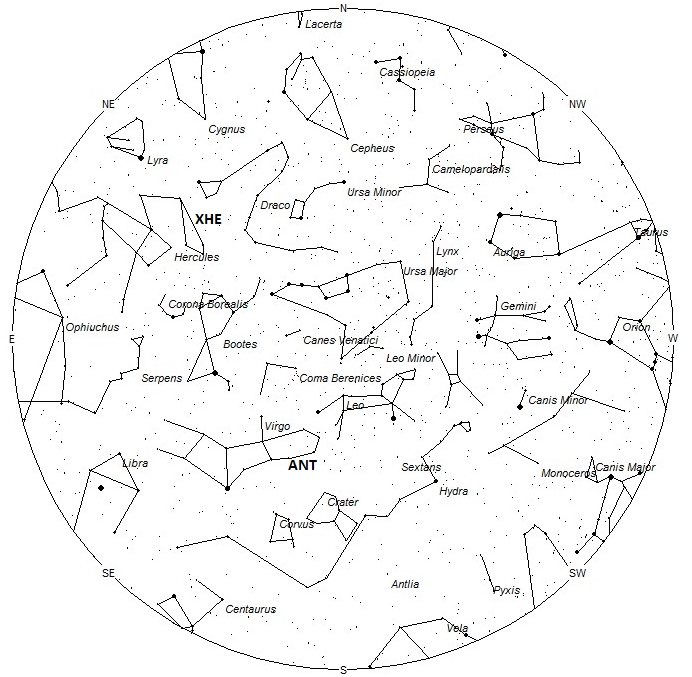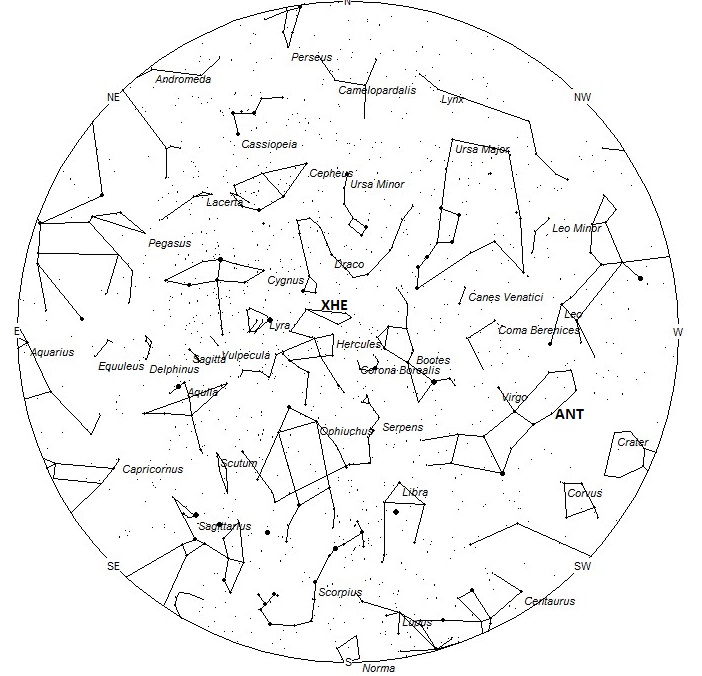
(Nikon D7000,
ƒ/3.5, 8.0 mm, 30s, ISO100)
During this period the moon will wane from nearly one-half illuminated to almost new (invisible). This weekend the nearly half illuminated moon will rise near 02:00 local standard time and will interfere with meteor viewing if it lies within your field of view. With each passing night the moon will become a bit thinner and will rise later in the morning providing the meteor observer with a better view of the heavens. The estimated total hourly meteor rates for evening observers this week is 3 as seen from mid-northern latitude (45N) and 5 from the southern tropics (25S). For morning observers the estimated total hourly rates should be near 6 as seen from mid-northern latitudes (45N) and 9 from the southern tropics (25S). The actual rates will also depend on factors such as personal light and motion perception, local weather conditions, alertness and experience in watching meteor activity. Evening rates are reduced by moonlight during this period. Note that the hourly rates listed below are estimates as viewed from dark sky sites away from urban light sources. Observers viewing from urban areas will see less activity as only the brighter meteors will be visible from such locations.
The radiant (the area of the sky where meteors appear to shoot from) positions and rates listed below are exact for Saturday night/Sunday morning March 10/11. These positions do not change greatly day to day so the listed coordinates may be used during this entire period. Most star atlases (available at science stores and planetariums) will provide maps with grid lines of the celestial coordinates so that you may find out exactly where these positions are located in the sky. A planisphere or computer planetarium program is also useful in showing the sky at any time of night on any date of the year. Activity from each radiant is best seen when it is positioned highest in the sky, either due north or south along the meridian, depending on your latitude. It must be remembered that meteor activity is rarely seen at the radiant position. Rather they shoot outwards from the radiant so it is best to center your field of view so that the radiant lies near the edge and not the center. Viewing there will allow you to easily trace the path of each meteor back to the radiant (if it is a shower member) or in another direction if it is a sporadic. Meteor activity is not seen from radiants that are located far below the horizon. The positions below are listed in a west to east manner in order of right ascension (celestial longitude). The positions listed first are located further west therefore are accessible earlier in the night while those listed further down the list rise later in the night.
These sources of meteoric activity are expected to be active this week.
.
The center of the large Anthelion (ANT) radiant is currently located at 12:12 (183) -01. This position lies in western Virgo, 2 degrees west of the 4th magnitude star known as Zaniah (eta Virginis). Due to the large size of this radiant, Anthelion activity may also appear from eastern Leo, and Crater as well as Virgo. This radiant is best placed near 0200 local daylight saving time (DST), when it lies on the meridian and is located highest in the sky. Rates at this time should be near 2 per hour no matter your location. With an entry velocity of 30 km/sec., the average Anthelion meteor would be of slow velocity.
The xi Herculids (XHE) were discovered by Sirko Molau and Javor Kac of the International Meteor Organization using video data from the IMO network. These meteors are active from March 8-12 with maximum activity occurring on the 10th. The current radiant position lies near 17:12 (258) +48, which lies in northern Hercules, 5 degrees southwest of the 3rd magnitude star known as Rastaban (beta Draconis). Rates are expected to be less than 1 per hour no matter your location. These meteors are best seen during the last dark hour of the morning when the radiant lies highest above the horizon in a dark sky. At 35 km/sec. this source would produce meteors of average velocities.
As seen from the mid-northern hemisphere (45N) one would expect to see approximately 4 sporadic meteors per hour during the last hour before dawn as seen from rural observing sites. Evening rates would be near 2 per hour. As seen from the tropical southern latitudes (25S), morning rates would be near 7 per hour as seen from rural observing sites and 4 per hour during the evening hours. Morning rates are reduced due to moonlight. Locations between these two extremes would see activity between the listed figures.
| SHOWER | DATE OF MAXIMUM ACTIVITY | CELESTIAL POSITION | ENTRY VELOCITY | CULMINATION | HOURLY RATE | CLASS |
| RA (RA in Deg.) DEC | Km/Sec | Local Daylight Saving Time | North-South | |||
| Anthelion (ANT) | – | 11:16 (169) +04 | 30 | 02:00 | 2 – 2 | II |
| xi Herculids (XHE) | Mar 10 | 17:12 (258) +48 | 35 | 07:00 | <1 – <1 | IV |
 American Meteor Society
American Meteor Society



March 11, 1014pm. from northwest to southeast. 7 seconds at about 40 degrees above the horizon.
I’m at 26.36.06.50 N 80.03.00.27 W
1100 South Lakeside Dr. Lake Worth, FL
time now: 3 11 18 10:34 PM
don’t know why this is saying it was 4 days ago. it was about 15 minutes ago.
One of the Herculids crash-landed in my backyard on March 10. It left a little crater and survived as a lump of tektite that’s currently sitting on my mantle.
Saw the brightest one I’ve ever seen on the way home from work near RT 24/79 merge headed north out of fall river, ma. Bright enough to be seen through thin clouds.
March 16, around 1 AM. Hastings on Hudson, NY (40.9945° N, 73.8787° W). Broad, long, bright swath through the sky, about 4 seconds. Clearly visible (and stunning) even with intense light pollution. Ever so slightly west of North, starting at about 66° up, fell almost straight down to maybe 15-20° above the horizon.